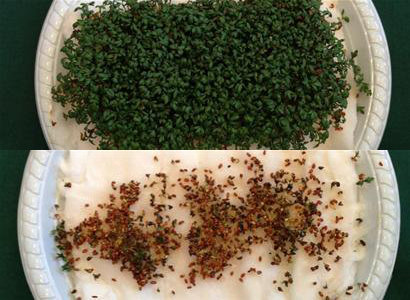Un grupo de escolares daneses ha descubierto que la radiación proveniente del Internet inalámbrico bloquea el crecimiento de las semillas de berro.
En un primer momento, las cinco estudiantes de la escuela Hyallerup querían investigar los efectos de las ondas del Wifi sobre las células humanas, pero al no disponer del material necesario para llevar a cabo su idea, decidieron cambiar de idea.
Para realizar el experimento, colocaron seis bandejas con semillas en una habitación en la que no había Wifi y otras seis en una que contaba con dos routers. Durante las doce semanas siguientes, las chicas observaron y fotografiaron cómo iban cambiando las semillas.
No necesitaron ningún instrumento complejo para darse cuenta de las diferencias entre unas y otras: las semillas que estaban en la habitación con Internet inalámbrico no brotaron, mientras que las otras se desarrollaron con normalidad.
Su motivación
La hipótesis de estas jóvenes decidieron estudiar este fenómeno a raíz de su experiencia personal. Varias de ellas notaron que dormían peor y se levantaban con dolor de cabeza si tenían el móvil cerca de la cama. Y no solo eso, también notaban que a lo largo del día estaban desconcentradas y les costaba estudiar.
Pero para su estudio no utilizaron móviles, sino routers. Según se recoge en la web de noticias DR.dk, tomaron esta decisión porque consideraban que un router emite las mismas ondas que uno de estos aparatos. Aunque esta explicación es errónea -un móvil y un router no emiten de la misma forma ni la misma cantidad de radiación- por lo menos pudieron constatar un cambio en las semillas, algo que seguramente no podrían haber hecho si hubieran utilizado un móvil.
Take 400 cress seeds and divide them into 12 trays. Then place the trays in two rooms at the same temperature, six in each room. Give the trays the same amount of water and sunlight over 12 days, but expose six of the trays to mobile phone radiation.
This is the recipe for a biology experiment so ingenious that it has attracted international attention from leading biologists and radiation experts. The experiment is the brainchild of five girls from class 9.b at Hjallerup School in North Jutland, and it all started when the girls were finding it difficult to concentrate in their lessons.
“We all thought we experienced concentration problems in school if we slept with our mobile phones at the bedside, and sometimes we also found it difficult sleeping,” explained Lea Nielsen, one of the five budding researchers.
The experiment
The school did not have the equipment to test the effect of mobile phone radiation on the girls themselves, which, as it turned out, was probably a good thing. Consequently, the girls had to find an alternative, and the solution they came up with was cress seeds.
Six trays of seeds were placed in a room with no radiation, while six were placed in another room alongside two routers emitting roughly the same type of radiation as an ordinary mobile phone.
The “healthy” cress, which was not exposed to radiation from the routers.
Then the girls just had to wait 12 days, observe, measure, weigh and take photos. The results spoke for themselves: the cress seeds alongside the routers did not grow at all, and some even mutated or died.
“It’s really frightening that there was such a big effect, and we were really struck by the results,” said Nielsen.
The “sick” cress, which was exposed to radiation from the routers.
The reactions
The experiment secured the girls a place in the final of the “Young Researchers” competition, but that was only the beginning. So far, leading researchers from the United Kingdom, the Netherlands and Sweden have shown great interest in the girls’ project.









